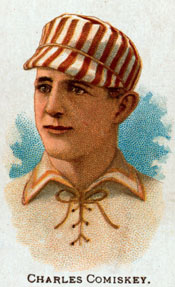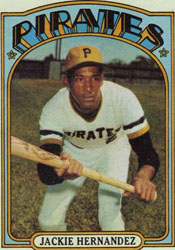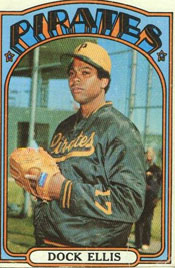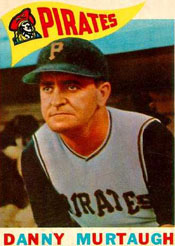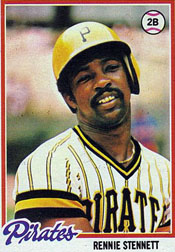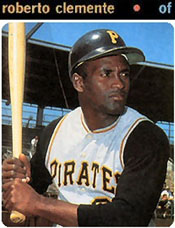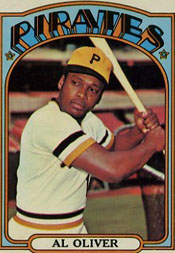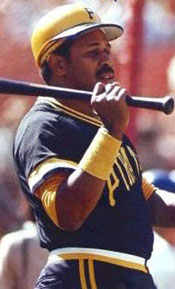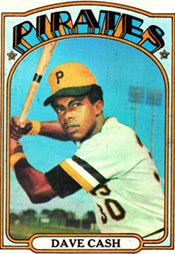|
|
Baseball Firsts Archive - VII
Cecil Travis did something in 1933 that not only was a first in the "modern" baseball era (since 1903) but is yet to be duplicated.
- Cecil went 5-for-7 in his first major league game for the Washington Senators in a 12-10 victory over the Cleveland Indians on May 16.
- The 19-year-old Georgia native had failed to make the team in spring training, but how could Manager Joe Cronin send him back to the minors after five hits in his first game!
- A left-handed hitting IF, Travis took over 3B for the Senators in 1934 before moving to SS in 1937.
- He made the All-Star team for the first time in 1938 and repeated in 1940 and 1941.
He missed the 1942-45 seasons while serving in the army during World War II.
- Travis would probably have made the Hall of Fame were it not for his lost seasons.
- During the Battle of the Bulge in 1944, he suffered a bad case of frostbite that required an operation.
- He returned to the Senators in 1946 at age 31, but was not the same player he had been before the war. After hitting .256 in '46 and only .215 in '47, he retired.
- Despite those subpar seasons, his career batting average is .314.
Note: Fred Clarke had five hits in five ABs in first game in 1894 for the Louisville Colonels of the National League.
|
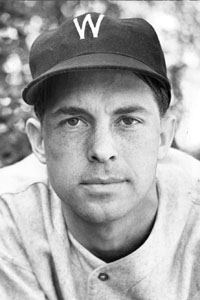
Cecil Travis |

Ralph Garr
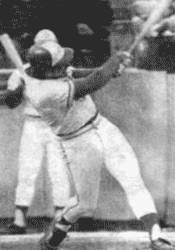
Doug Ault
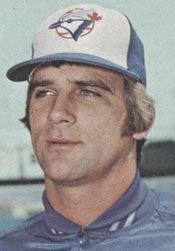
Pete Vuckovich
|
In 1977, the American League expanded to 14 teams with the addition of the Seattle Mariners and Toronto Blue Jays. Since Montreal had joined the NL in 1969, the Blue Jays gave Canada its second ML franchise.
- On April 7, 1977, the Blue Jays' first home game left many questioning whether putting a team in Toronto was such a good idea. The weather was freezing cold, and the entire field at Exhibition Stadium was covered in snow. Players and fans alike wondered if the game would be "snowed out."
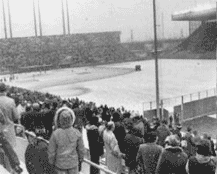 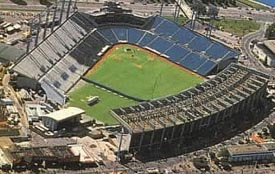 Exhibition Stadium, Toronto, for its opener (left) and in sunnier weather
Exhibition Stadium, Toronto, for its opener (left) and in sunnier weather
- The groundskeepers vacuumed up the snow, and, after an 18-minute delay, the first American League game in Canada began before 44,469 spectators.
The Blue Jays defeated the Chicago White Sox that day, 9-5.
- The opening pitch was delivered by RHP Bill Singer.
- The first batter, LF Ralph Garr, walked. He stole second, advanced to third on a wild throw, and scored the first run on a SF.
- The first hit was a homer by the next hitter, RF Richie Zisk.
- Toronto's first hit was also a four-bagger, by 1B Doug Ault in the bottom of the first. He thereby scored the franchise's first run.
- The victory went to reliever Jerry Johnson, with the first save by Pete Vuckovich.
The Blue Jays quickly became one of the AL's most successful franchises.
- Despite finishing seventh (last) in the AL East, they drew 1,701,052 fans in that first season.
- The Jays attracted over 6 million fans in their first four seasons, a major league record.
- In 1987, Toronto set several league attendance records: 2,778,459 fans at home games, 1,959,280 fans at road games, and the overall home/away game attendance record.
In 1989 the Blue Jays moved from Exhibition Stadium to the SkyDome in downtown Toronto.
- Their first full year in the SkyDome, the team drew over 4 million fans at home, an all-time major league attendance record.
- The Blue Jays have been division champions 5 times, and in 1992 and 1993 became the first Canadian-based team to win the World Series.
|
A significant rules change was approved by the National League for the 1884 season. Here are the relevant passages from Spalding's Official Base Ball Guide 1884 (which was reprinted in its entirety in 1987 by Horton Publishing Company).
- "The rules governing the pitching in 1883 prohibited a direct overthrow of the ball to the bat; this rule, however, became practically a dead letter during the latter half of the season, through the failure of the Umpires to inflict the penalty provided for its violation. Instead of amending the rule so as to provide for its strict enforcement, – a very difficult thing to do, by the way, – the League decided to repeal the prohibition, thereby allowing a direct over-throw of the ball to the bat. This was done partially as an experiment, to see what would be the practical result of the delivery by overhand throwing, and it is only by experiments of this kind each season, that the game can be advanced on the road to a perfect code of playing rules."
- "As the rule now is, the pitcher can deliver seven swiftly over-thrown balls to the bat which are either not over the base or not at the height called for, before he can be punished by sending the batsman to his base on called balls; whereas, the batsman is obliged to strike at the first three fair balls sent to him, or he will be given out on strikes."
The Guide mentions several other rules changes for 1884.
- "One of the advatageous amendments made by the League was that repealing the rule which decided the base-runner out for not running to first base. By this rule, if three men were on the bases when the third strike was called, all the base runner had to do was throw down his bat and stand still, that act alone putting him out, and at the same time preventing the runners on the bases from being forced off by the act of the base runner to first base. The amendment establises the old rule which obliges the base runner to start for first base, and he cannot now be out on three strikes – if not caught out – unless touched by the catcher, a fielder, or throw out at first base. This amendment enables the catcher to affect a double or triple play, by not catching the ball on the third strike, but simply touching home base, and then throwing to third base, leaving the ball to be passed to second from htird, or to first base to throw out the base runner from home base."
- "Another excellent amendment was the new rule which makes it imperative for a fine of five dollars to be inflicted on each and every player who in any way disputes the decisions of an Umpire, or who even addresses the Umpire on any point of play on which he has rendered a decision. The captains of the nines are alone exempt from this special fine, and they only to the extent of either explaining a misinterpretation or desiring an explanation of the Umpire's ruling."
|
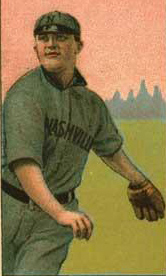
Baseball Pitcher 1884
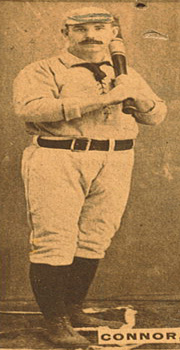
Batter of the 1880s
|
One Man – Two World Series Records
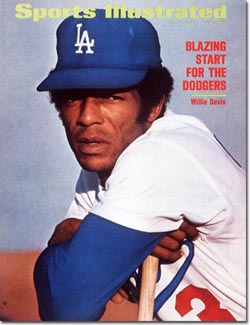
|
Willie Davis, who died March 9, 2010, holds two World Series records – one positive, one negative. (And every record you set is, by definition, a first.)
- Playing for the Los Angeles Dodgers in 1965, he became the first player to steal three bases in a Fall Classic game. He did this in the fifth game against the Minnesota Twins. All were steals of second in LA's 7-0 win at Dodger Stadium. (He did not steal three bases in one inning as was erroneously reported in the New York Times after his death.)
- The next year, he became the first to commit three errors in one inning in the World Series. In the top of the fifth of a scoreless Game 2 against the Baltimore Orioles in Dodger Stadium, CF Davis lost Paul Blair's fly ball in the sun. The runner on first, Boog Powell, reached third and Blair, second. The next batter, Andy Etchebarren, hit a short fly that Willie dropped. Then he overthrew 3B, allowing Blair to score and Etchebarren to reach third. The Orioles' three runs in the inning were all unearned. Willie's blunders epitomized LA's poor play in the Series, a four-game Baltimore sweep.
Davis still holds multiple Dodger records from his 14-year career with the club.
- His 31-game hitting streak in 1969 was the longest in the majors since Dom DiMaggio's 34 for the Red Sox in 1949.
- Willie's other five Dodger records are: hits (2,091), extra-base hits (585), at-bats (7,495), runs (1,004), triples (110), and total bases (3,094).
|
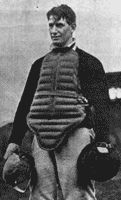
C Roger Bresnahan
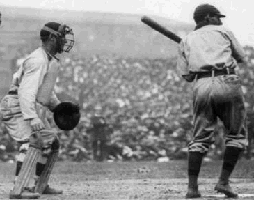
Bresnahan wearing shin guards |
Hall of Fame C Roger Bresnahan invented the first shin guards in 1907.
- He modeled the first pair after cricket leg pads. Since they were large and bulky, they didn't catch on with other backstops.
- When Bresnahan wore the guards on opening day for the New York Giants, Pittsburgh manager Fred Clarke objected, but the umpires allowed them. When the Giants won, Clarke protested the game but National League President Pulliam rejected the appeal.
- Clarke was adamant in claiming that the equipment gave Bresnahan an advantage, as he told Sporting Life (5/14/1907):
As the matter stands at present New York has a big advantage over every other club," declared Clarke. "With Bresnahan the only catcher in the league wearing these guards, it will be next to impossible for any opposing player to touch the plate in a close play on the Polo Grounds. I am not stretching the truth a particle when I say that those shin guards cost us Saturday's game. Bresnahan ran fully six feet to the left of the plate and braced himself on the line so that it was impossible for me to get around him in my attempt to score on the bunt. Of course
I tried to slide, but my spike caught in his shin guards and caused me to turn one of my ankles.
- By 1909, Bresnahan had streamlined the design and his invention became more widely used.
- Although standard sources credit Bresnahan with being the first C to wear shin guards, another item in Sporting Life (5/20/1907) raised questions about that claim.
NOT SO NEW.
Bresnahan Leg-Guard Scheme Anticipated by a Minor Catcher.
Sharon, Pa., May 20. Roger Bresnahan, the Giants big catcher, is not the first professional catcher to wear shin guards. The newspapers have been devoting considerable space to the shin guards and claiming they are an innovation. They are not new in the Ohio and Pennsylvania League, for Fox, catcher for Lancaster, last year with Mansfield, wore them under his stockings all season. Fox had been getting frequent knocks on the shins from foul tips and concluded the only way to stop it was to
wear shin guards. The public seemed surprised every time Fox got a crack on the shin and he would smile. Ordinarily the blow would cause a catcher to limp for several minutes. It took some time for the spectators to learn that Fox wore shin guards under his heavy stockings. He is wearing the guards now and hasn't a black or blue mark on his shins.
|
President Attends World Series
It's widely known that William Howard Taft was the first president to throw out the first ball of the season (in 1910). However, it is less well known that the first president to attend a World Series game was Taft's successor, Woodrow Wilson.
- The president and his fiancee, Mrs. Edith Bolling Galt, a widow, attended Game Two of the 1915 Fall Classic between the Philadelphia Phillies and the Boston Red Sox on Saturday, October 9 at Baker Bowl.
- In addition to establishing a baseball first, the appearance of the First Couple was their first in public since the announcement of their engagement three days previously. Wilson's first wife, Ellen Axson, had died in 1914.
- The game was delayed for a few minutes until the presidential entourage arrived. The president then threw out the first ball, and the game began.
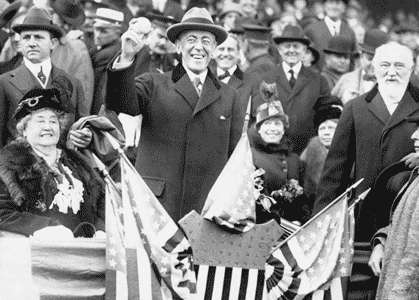 President Woodrow Wilson at 1915 World Series; his fiancee is behind him and not visible.
President Woodrow Wilson at 1915 World Series; his fiancee is behind him and not visible.
- According to the New York Times:
He's a real fan, the President. He knows when Tris Speaker comes to the bat without looking at his score card, and he can clutch his fist and smash his knee and exclaim: "Well done!" when a player twists himself into a knot and makes a circus catch. He coached Mrs. Galt often during today's big struggle, and told her when Cactus Cravath was at the bat, and pointed out Silent Pat Moran as he walked to the coaching lines. Mrs. Galt seemed to become a fan very quickly, too. She ducked her head every time a foul was hit into the crowd.
The Red Sox evened the series with a 2-1 win before 20,306.
- The star of the game was the "little Boston pitcher" George Foster, who pitched a three-hitter and drove in the winning run in the ninth with his third hit, a single.
- Amazingly, the Red Sox won the next two games at home by that same 2-1 score, then closed out the Phillies in the fifth game, 5-4, back in The City of Brotherly Love.
|
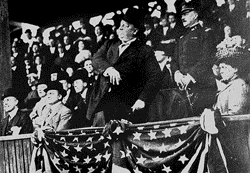
President Taft throws out first ball in 1912.
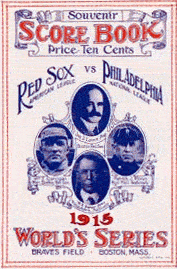
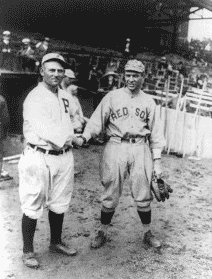
Gavvy Cravath and Tris Speaker
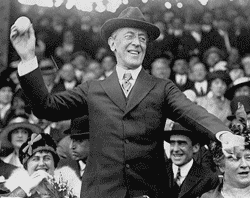
President Wilson throws out first ball in 1916. His new First Lady is at the left.
|
The coach's boxes were added to baseball fields in 1887. The reason for their creation may surprise you.
- In the 1880s, the St. Louis Browns of the American Association became notorious for rowdyism.
- Manager Charles Comiskey - yes, he who later owned the infamous Chicago "Black Sox" and named the club's stadium after himself - encouraged his players to try to knock the opponents off their game by constant verbal abuse.
- Whichever player coached 3B ran up and down the line hurling insults and obscenities at the P. Since the Browns won, other clubs imitated them.>
- To curb this nonsense, the rules committee recognized coaches for the first time and created the boxes next to 1B and 3B for the 1887 season.
Reference: The New Bill James Historical Baseball Abstract
|
|
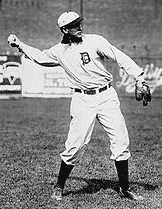
Ed Summers
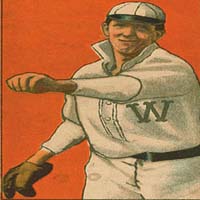
Dolly Gray
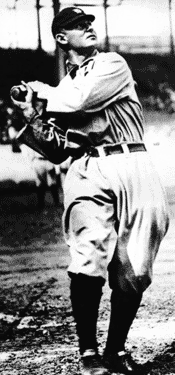
Sam Crawford |
July 16, 1909: Bennett Park, Detroit
At 3:30, Oron Edgar "Kickapoo Ed" Summers took the mound for the Tigers against Washington's rookie hurler Dolly Gray. 18 innings. At 6:45 pm, home plate umpire John Kerin called the game because of darkness, much to the displeasure of both players and spectators. For 3 hours and 15 minutes, neither team crossed the plate in the first 18-inning scoreless game of the 20th century.
- Summers went the distance, pitching the equivalent of two games. He surrendered only 7 hits with 2 walks (one of which was intentional) and 10 K.
- Gray pitched 8 innings, yielding only one hit while walking one. He didn't strike out a batter. He was taken out in the ninth when he apparently tore a muscle in his side while pitching to the leadoff batter.
- Dolly's replacement, Bob Groom, gave up 5 hits, walked 6, and struck out 8 in 10 innings.
The Tigers, leading the junior circuit by 3 games, thought they won the game in the 15th inning.
- C Oscar Stanage led off with a single to CF and was replaced by PR Red Killefer.
- Summers bunted to Groom who threw the ball into CF, allowing Killefer to continue to 3rd.
- The Senators intentionally passed LF Matty McIntyre to create a force at any base.
- SS Donie Bush popped out to 3B Speed Kelly.
- CF Sam Crawford topped the ball toward 1B. Groom fielded it and tossed it to his C. Killefer slid as C Gabby Street applied the tag. Kerin gave the safe sign.
- At that point, the players on both teams thought the game was over and began exiting the field. But Kerin stayed behind the plate, calling the players to resume their positions. "What's the matter?" one of them asked. "Runner's out," came the reply. Besieged by both teams, the ump explained that he forgot the bases were loaded and therefore thought Street needed to tag the runner. But Killefer was really out on a force play at home.
- Crawford started back toward first as 2B Bob Unglaub grabbed the ball from Street and began chasing Wahoo Sam as the 3,078 fans howled. Each of the three Detroit runners managed to return to his base without being tagged out.
- After a few more minutes of rhubarb, RF Ty Cobb stepped to the plate with the bases still loaded. But Groom struck him out, "ending one of the most bizarre half-innings in baseball history."
In 1909, tied games were not suspended but instead replayed in their entirety. On August 22, the Nationals and Tigers replayed the July 16 tie in its entirety with Detroit the victor, 3-1.
Reference: Baseball Records Registry, Joseph J. Dittmar
|
The first two games of the 1949 World Series produced two firsts in baseball history.
- Rookie 17-game winner Don Newcombe of the Brooklyn Dodgers became the first African-American P to start a World Series game when he took the mound in Yankee Stadium. The big righthander pitched outstanding ball, matching Allie Reynolds goose egg for goose egg until the bottom of the ninth, when 1B Tommy Henrich led off with a HR into the lower RF stands, the fifth hit for the Yankees.
- The second game produced another pitching masterpiece. The Dodgers pushed across a run off Vic Raschi in the 2nd on 2B Jackie Robinson's double and 1B Gil Hodges' single. Wily lefty Preacher Roe made the tally stand up with a 6-hit shutout. The result was the first time a World Series had included two 1-0 games.
- The Yankees won all three games at Ebbets Field to take the crown in five. The fifth game produced another first when the contest was finished with the lights on.
|
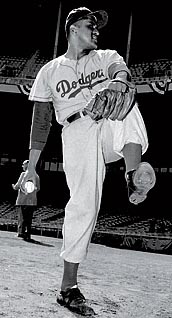
Don Newcombe |
|
|
The date was September 1, 1971. The Pirates hosted the Phillies at Three Rivers Stadium.
- Pittsburgh manager Danny Murtaugh started this lineup.
Rennie Stennett 2B
Gene Clines CF
Roberto Clemente RF
Willie Stargell LF
Manny Sanguillen C
Dave Cash 3B
Al Oliver 1B
Jackie Hernandez SS
Dock Ellis P
- What was so special about this lineup? Every player is either Afro-American or Hispanic. That was a first in ML history.
- Dave Cash recalled that the batboy said, Hey, the Homestead Grays are playing today. The reference was to the former Negro League team in Pittsburgh.
- Murtaugh didn't intentionally create a historical first. He simply put the best lineup on the field for his team, which led the NL East by 5.5 games over St. Louis.
- The Pirates won that night 10-7 on their way to the NL East crown.
- They captured the NL flag 3 games to 1 over the San Francisco Giants.
- Then they upset the Baltimore Orioles, the last team to boast three 20-game winners, in the seven-game World Series.
- Al Oliver recalls the early 70s fondly. If it weren't for the Latino ballplayers during those years, we wouldn't have had a chance to go to the 1971 World Series.
|
|
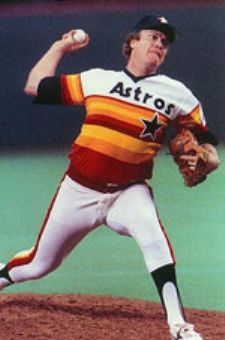
Mike Scott
|
The 1986 National League Championship Series was one of the most gripping ever.
- The New York Mets won in six games over the Houston Astros.
- Both the Astros victories went to RHP Mike Scott in Games One and Four.
- Mike pitched a 5-hit shutout in the opener at the Astrodome to make Houston's second-inning run stand up.
- At Shea Stadium four days later, Scott twirled a 3-hitter to win 3-1. He again finished what he started.
- The Astros desperately tried to send the Series to a seventh game so that Mike could take the hill again but lost the fifth game in 12 and the sixth game in 16.
Scott's brilliance earned him the MVP award for the series - the first time the award went to a player on the losing team.
|

Larry MacPhail
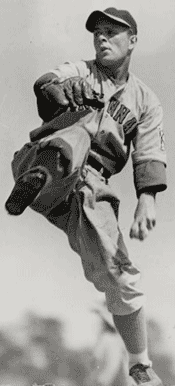
Johnny Vander Meer
|
The first two major league clubs to stage night games played in the National League.
- The Cincinnati Reds beat the Philadelphia Phillies 2-1 on Friday, May 24, 1935 at Crosley Field before 20,422 fans.
- It took more than three years before a second club, Brooklyn, hosted a contest under the lights. It is no coincidence that the Dodgers' GM, Larry MacPhail, had conducted the first night game when he held the same position for the Reds.
- On June 15, 1938, the Dodgers lost to Cincinnati 6-0. Johnny Vander Meer pitched his second straight no-hitter that night, the only time that feat has been accomplished in ML history. 38,748 packed Ebbets Field.
The first AL club to put its toe in the water of night baseball was the Philadelphia Athletics on May 16, 1939.
- A disappointing crowd of 15,109 saw Cleveland defeat the last place A's 8-3 in 10 innings. Still, the attendance was better than what Connie Mack's club would have drawn in the daytime that Tuesday.
- The Cleveland Plain Dealer considered the event significant enough to merit the top front page headline the next morning.
- The Tribe tied the game with two in the eighth, then took advantage of Leroy Parmelee's four walks in the tenth to secure victory.
- The temperature dropped from 54° at the start to 46° at the end.
- While most of his teammates agreed the lighting system "wasn't so bad," Cleveland 3B Ken Keltner said: It's a lousy lighting system. I've played under better ones in the minors.
- The Indians also didn't think the world would end if night baseball became universal. Frankie Pytlak: This stuff about night ball being different from day ball is mostly in a guy's mind. I can't see enough difference to mean anything, especially on a field as well lighted as this one.
- However, Hal Trotsky disagreed. I thought the outfield looked a little dark in spots, but the infield was great and it wasn't so bad at the plate, either. I missed a couple of balls that I think I'd have murdered in the daytime, but on the whole I couldn't find much to squawk about. After all, if we're goin to make a living, we have to play where the crowds will come.
|
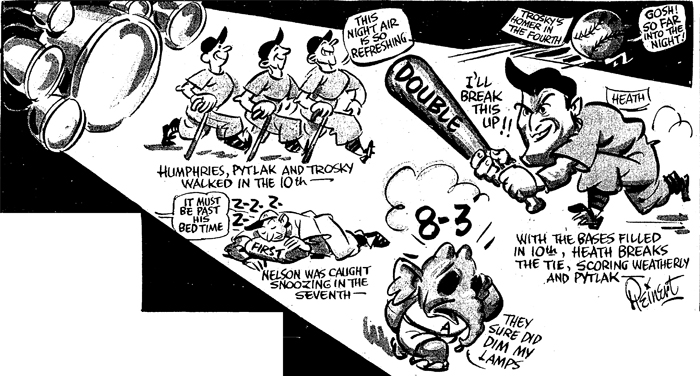 Cleveland Plain Dealer
Cleveland Plain Dealer cartoon after previous night's game in Philadelphia |
Not all major leagues owners weren't sold on night ball, though.
- They restricted any club that installed lights to seven night games per year, one for each visiting team.
- Yankee GM Ed Barrow was the most outspoken critic, declaring that his club would never play night games at home. He claimed the cost would be prohibitive. Putting lights into the stadium will entail a tremendous outlay - at least a quarter of a million dollars. It is the hardest of all the parks to light and the big steel towers would cost a fortune. (The lighting system in Cincinnati cost only $60,000.) He also feared night baseball would upset the "balance and harmony" of his highly successful organization.
Before the 1939 season ended, three other teams started night ball.
- The Phillies, who shared Shibe Park with the A's, hosted Pittsburgh under the lights on June 1.
- The Indians played their first home night game on June 27. (A little over two years later, Municipal Stadium would host one of the most famous night games in history, when Joe DiMaggio's 56-game hitting streak came to an end thanks to two sensational stops by Keltner.)
- The White Sox got into the act on August 14 against the St. Louis Browns.
It took until 1948 for all sixteen clubs except the recalcitrant Cubs to install lights.
- 1940 saw four more clubs install lights: both St. Louis teams, who shared Sportsman's Park, the New York Giants, and the Pirates.
- The Washington Senators were the only newcomer in 1941.
- After a delay of four years during World War II, the Boston Braves and New York Yankees joined the after-dark contingent in 1946. Again, it is no coincidence that the Yanks' GM was none other than Larry MacPhail, who succeeded Barrow.
- The Red Sox installed lights in 1947. The last AL holdout, the Detroit Tigers, joined the crowd in 1948.
- The Cubs held out until August 1988.
|
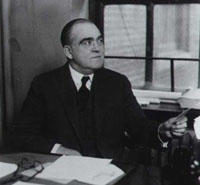
Ed Barrow |
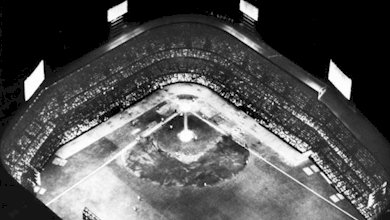
First night game at Briggs Stadium, Detroit |
|








